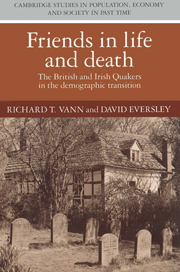Book contents
- Frontmatter
- Contents
- List of figures
- List of tables
- Preface
- Introduction
- 1 The quality of the sources
- 2 Characteristics of the sample
- 3 Marriage according to Truth
- 4 The fruitfulness of the faithful
- 5 The quality and quantity of life
- Conclusion
- Bibliography
- Index
- Cambridge Studies in Population, Economy and Society in Past Time
Preface
Published online by Cambridge University Press: 23 September 2009
- Frontmatter
- Contents
- List of figures
- List of tables
- Preface
- Introduction
- 1 The quality of the sources
- 2 Characteristics of the sample
- 3 Marriage according to Truth
- 4 The fruitfulness of the faithful
- 5 The quality and quantity of life
- Conclusion
- Bibliography
- Index
- Cambridge Studies in Population, Economy and Society in Past Time
Summary
The technique of family reconstitution, on which this book is based, has been used in various ways since 1915. We first got the idea for our joint project thirty years ago, not suspecting how long it would take to bring it to fruition. Our task has been complex, but we have been fortunate in having a multitude of helpers.
The two of us began independently, and from different points. David Eversley in the early 1960s discovered the Irish family lists and took the first steps towards a reconstitution of the English Quaker population as well; while Richard Vann, approaching demography from the context of Quaker social history, hoped both to refine some crude demographic figures established for two English counties and to extend the sample to an entire region. In 1966 it became apparent that there would be great advantage to combining our efforts, and since April of 1967 our two files have been integrated, though the materials on Ireland, Scotland, Wales, the northern counties of England, London, and the family histories were compiled under the supervision of Eversley, while most of the urban families (from Bristol and Norwich) and those from Southern England were the responsibility of Vann.
Among the collaborators whose help was vital in the completion of our work first mention must go to the ESRC Cambridge Group for the History of Population and Social Structure.
- Type
- Chapter
- Information
- Friends in Life and DeathBritish and Irish Quakers in the Demographic Transition, pp. xvi - xxPublisher: Cambridge University PressPrint publication year: 1992

